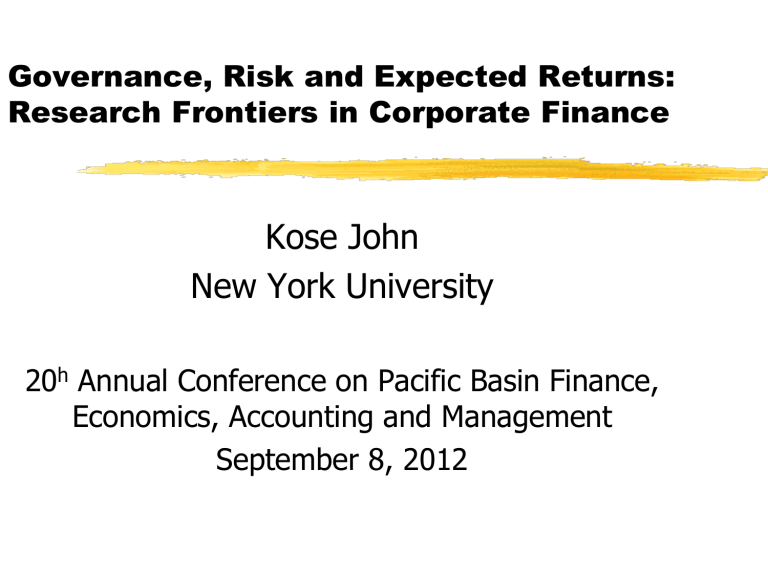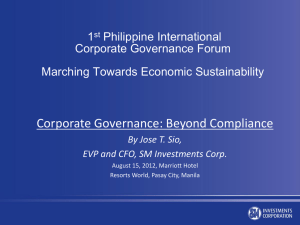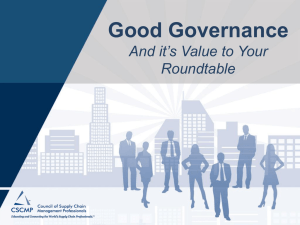Governance, Risk and Expected Returns

Governance, Risk and Expected Returns:
Research Frontiers in Corporate Finance
Kose John
New York University
20 h Annual Conference on Pacific Basin Finance,
Economics, Accounting and Management
September 8, 2012
Introduction
• Corporate Governance and CEO compensation
• Research areas in Finance, Economics,
Management, Accounting and Law
• Appropriate for PFEAM September 2012
• Many central issues remain for future research
• Opportunities in theoretical and empirical work
• Surveys:
• Bolton, Becht and Roell (2003)
• Aggarwal (2008)
Recent Surveys
• P. Bolton, M. Becht and A. Roell, “Corporate
Governance and Control”, the Handbook of the
Economics of Finance, edited by George
Constantinides, Milton Harris and René Stulz, North-
Holland, 2003.
• Rajesh K. Aggarwal, “ Executive Compensation and
Incentives,” In: Eckbo,B.E. (Ed.), Handbook of
Corporate Finance: Empirical Corporate Finance, Vol. 2.
In: Handbooks in Finance Series. Elsevier/North-
Holland, Amsterdam, 2008.
Overview
• Very interesting interaction between risk and corporate governance
• Very interesting interaction between risk and executive compensation
• Interface of Corporate Finance and Asset Pricing
• Research Issues in these areas and some existing work
• Open Research Questions
• Central Questions remain yet unanswered
• Relation to Global Financial Crisis
Relationship between
Governance and Risk
• Governance and Risk are closely related
• Holmstrom—Risk-neutral agent case
• Risk complicates design of executive compensation
• Partial ownership agency problems
• Risk complicates governance problems
• Example:
• Even more so in a dynamic environment
• Even more so in a competitive environment
• Relative Governance
Governance and Risk
Compensation and Risk
• Governance and Systematic Risk
• Governance and Unsystematic Risk
• Governance and Bondholders
• Governance and Dividends
• Tail Risk and Fake Alphas
• Deferred Compensation and Claw-Back
Provisions
Corporate governance
• Basic theory is missing.
• Going beyond the agency theory: some central issues.
• Incomplete contracts: how institutional mechanisms (legal, financial, banks, markets) evolve to improve governance and make up for the gap in contracting?
Corporate governance (cont’d)
• Why takeovers, monitored debt, board of directors, large institutional block holders arise as governance mechanisms?
• John and Kedia (2009), John and Kedia(2010)
• How do these interact with each other?
• Stakeholder governance?
• Debt holder governance?
• Optimal bankruptcy systems? How do they interact with corporate governance mechanisms?
Corporate governance (cont’d)
• How does competition affect corporate governance?
• What role do financial markets play? Corporate governance and the ability to transfer large stakes of ownership.
• Market economies vs. bank-centered economies?
• Financial policy and corporate governance: debt and governance, dividends and governance?
• Economy-wide governance vs. firm-specific governance?
Overview Of Some
Theoretical Research
• Design of Governance
• How is the optimal governance system structured in different economies
• Growth and Governance
• How does the optimal governance change as firms grow and economies grow
• Governance and regulation
• Positive and negative externalities
• Limited liability organizational forms and bailouts
• Institutional umbrella and noninvasive regulation
Executive Compensation and
Risk
• Large number of articles
• Explosive Growth in options and articles
• Wedge
• Tying the undiversified CEO in an illiquid fashion
• Restricted stocks, options
• Not characterized the benefits of incentive compensation (theoretically or empirically)
• Central trade-off
Central Issues
• What is the optimal structure of a well-designed compensation package?
• Optimal blend of restricted stocks and options?
• Theoretical and empirical work?
Central issues (cont’d)
• The correct pay-for-performance metric?
• Does it measure the strength of managerial incentives?
• Appropriate for non-linear compensation structures?
• Appropriate for large firms and small firms?
Central issues (cont’d)
• Level of CEO compensation?
• Too large, or too small?
• The right institutional structure and process to determine CEO compensation?
Dynamic issues
Usual incentive compensation
Manager augments the firm cash flow with a portfolio of holdings designed to add the return distribution
10% with prob. 0.9999 and -10,000 % with prob.
0.0001
This can be constructed with derivatives in a selffinancing portfolio
Sequence of years with good performance and hence bonuses. Disaster state in the 20 th year.
Dynamic Issues (cont’d)
• With such institutional convexities:
• Optimal intertemporal compensation structure?
• Deferred compensation?
• Claw-back provisions?
• Long-term vesting?
• Incentive structures in compensation and disclosure. High-powered incentives also provide incentives to exaggerate performance. Earnings smoothing.Competition?
Literature -Empirical
La Porta et al. (1997, 1998, 1999, 2002)
• Legal Protection is an important determinant
• Better legal protection is associated with
- Lower concentration of ownership and contro
- More valuable stock markets
- Higher number of listed firms and evaluation
Literature-Empirical
• Gompers, Ishi and Merrick (2003)
• US firms in the top decile of a “governance index” (related to takeover defenses and shareholder rights) earned significantly higher abnormal returns over those in the lowest decile.
• There are a large number of articles building on GIM.
Still the effect of governance on excess returns and value remains unclear.
• Firms that increase governance do not show that increases in performance follow.
Literature-Empirical
• Governance and risk-taking by managers.
• Governance and systematic priced risk.
• Relative governance.
• Optimal level of governance is endogenous.
• Governance simultaneously chosen with financial policy variables, and incentive features in CEO compensation.
Relationship between Financial
Crisis and Governance
• Governance failures and financial crisis?
• Two objective functions?
• Banks holding on to toxic assets and not lending
• Dark side of complete markets
• Fake alphas and systemic risk
• Deferred compensation and Claw backs
• Competition?
• Dynamically optimal compensation structures
• Transparency of derivative trading
• Centralized Clearing
Literature Empirical (cont’d)
• Cremers, Nair and John (RFS, 2009)
• John, Litov and Yeung (JF, 2008)
• John and Litov (NYU WP, 2009)
• John and Kadyrzhanova (NYU WP, 2009)
• John and Knyazeva (NYU WP, 2009)
• John, Knyazeva and Knyazeva (JFE, 2011)
• John and Kadyrzhanova (NYU WP, 2012)
• Francis, John, Hasan and Waisman (JFE, 2010)
Literature Empirical (cont’d)
• Survey: Morck, Wolfenzon and Yeung (JEL,
2005)
• Xiaoji Lin (JFE February 2012)
• Aslan and Kumar (RFS July 2012)
Takeovers and the Cross-Section of Returns
John, Cremers, and Nair
RFS 2009
The impact of takeovers on valuation
Takeover activity: idiosyncratic or (partly) systematic?
Bruner (2004); Rhodes-Kropf & Viswanathan (2005)
Time-varying, takeover waves
Related to equity market conditions
Potential effect significant
Mitchell and Stafford (2003)
Median bid premium 1980-1998: 35%
Lots of M&A: 3,467 completed deals in 1980-1998
Takeover impact on expected returns
Takeover likelihood
Proxy for the exposure to (unobserved) state variables determining the cash flows & price of risk
More sensitive to cash flow shocks: higher required rate of return
Why? You receive cash (takeover premium) when you least need it (when the market is doing great).
Quintet of empirical results
• Abnormal returns related to takeover vulnerability, ‘Takeover’ factor
• Using estimates of takeover likelihood, construct a takeover spread portfolio
• Relative to Fama-French-Carhart four-factor model, 11.7% annualized abnormal return
Takeover factor predicts real takeover activity
• Explains differences in cross-section of equity returns Crosssectional pricing of BM/size-sorted portfolios
• Relation to to governance portfolios: Decrease significantly once we add the Takeover factor to the asset-pricing model
Corporate Governance and
Managerial Risk-Taking: Theory and
Evidence
Kose John, Lubomir Litov,
Bernard Yeung
Journal of Finance 2008
What is this paper about?
Large existing literature
Better investor protection lower cost of capital, more informed and developed capital markets, better capital allocations
faster growth
Offer an additional angle
Better investor protection managers undertake more value enhancing risky investment faster growth
A model + empirical evidence
Governance and Risk
Provide an agency-based rationale for the linkage between investor protection, risktaking and growth.
Corporate managers are sub-optimally conservative in the presence of large perks.Better governance mechanisms lower perks, leading to more value-enhancing risky investments.
Corporate accountability and risk-taking.
Risk-taking and growth.
Not caused by income-smoothing
Merger Waves and Relative Governance
Kose John, NYU Stern
Dalida Kadyrzhanova, University of Maryland
Motivation
Classical agency view
Contestable market for corporate control disciplines managers (Manne (1965), Scharfstein (1988))
Resilient puzzle: weak or no relation between ATPs and outcomes in the market for corporate control
Takeover Premiums (Comment & Schwert (1995))
Takeover Likelihood (Bates, Becher, & Lemmon
(2008))
“ Overall, the evidence is inconsistent with the conventional wisdom that board classification is an antitakeover device that facilitates managerial entrenchment ” (BBL (2008))
Main Results
• Relative Governance in a peer group of firms matter
• During merger waves the protection from ATMs make a significant difference.
Agency Costs of Idiosyncratic Volatility,
Corporate Governance, and Investment
Kose John, NYU Stern
Dalida Kadyrzhanova, University of
Maryland
Motivation
Identifies new fundamental conflict of interest due to firm-specific uncertainty ‘Dark side’ of IT shocks
Agency problem may arise since managers are exposed to total risk, while shareholders aren’t
Managers are under-diversified due to the specificity of their human capital, equity incentives, etc.Welldiversified shareholders only care about systematic risk
Key insight: Agency problem is likely to be more severe when the
wedge
between total risk and priced risk (IVOL) is high Amihud & Lev (1981)
Main Hypotheses
Behavioral hypothesis:
Managers of high IVOL firms will want to turn down too many risky projects & accept too many safe projects
IVOL hypothesis :
Agency costs of idiosyncratic volatility are higher for firms with ATPs, whose managers are more entrenched. First-order effect is on capital budgeting decisions (corporate investment, R&D)
Empirical Evidence
Robust evidence of agency costs of IVOL: for high IVOL firms, entrenchment (ATPs) leads to excess managerial conservatism, i.e.
1.
lower R&D & higher Capex expenditures
2.
higher likelihood of diversifying acquisitions
3.
lower firm value (Tobin’s Q)
New GMM approach to deal with omitted variables and reverse causality
To address reverse causality, additional evidence from
“natural experiment”
Governance shocks (passage of state BC laws)
IVOL shocks (industry IT intensity shocks)
Concluding Thoughts
• Governance and Risk are closely related
• Top-Management compensation and Risk are closely related
• Opportunities abound to make central research contributions
• Governance, Compensation and Systematic Risk
• Corporate Finance and Asset Pricing
• Dynamic Issues
• Effect of Competition
Conclusions
• Need more theory
• Need more careful empirical work
• Perhaps more structural models of governance and CEO compensation
• More calibration in corporate finance to sort out first order and second order effects in governance






